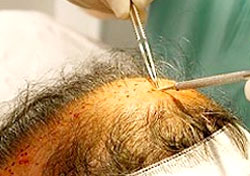About 25% of men start to experience the first signs of balding by the time they reach the age of 20 and it has been found that in the United States alone, 40 million men suffer from male pattern baldness. Because of this, the demand for hair loss treatments is quite high. A few years back, researchers from the University of Pennsylvania discovered the possibility of using stem cells to treat hair loss. They were able to isolate the stem cells, which are responsible for the growth of hair follicles. Although stem cell cloning is not a new concept, it has only been recently that science was able to consider it as a possibility to treat hair loss problems.

Understanding How Hair Transplant Stem Cell was Discovered
Researchers from the university’s School of Medicine were studying the wound healing process in mice when they learned that as their wounds heal, new hair follicles would come out from the new skin. Upon taking a closer look, they found out that it was the stem cell that was responsible for the formation of cells and tissues that make up the hair follicles. Up until that time, people were made to believe that the number of hair follicles a person could have in his lifetime was set but now, they realize that this is not entirely true.
Follicular Cell Implantation
The biotechnological technique that evolved from the hair transplant stem cell discovery is called follicular cell implantation. Although many surgeons call it stem cell hair cloning, authorities would prefer the former term in order to be more accurate. In any case, the procedure involves taking a scalp biopsy as a means of obtaining some hair follicles and to ensure that no pain is felt during the process, local anesthesia is injected. This step will take only about half an hour to finish. The extracted hair follicles will then be dissected in order to get the papilla, roughly 200 to 400 papilla cells per follicle. Once the dermal papilla cells (DPCs) have been obtained, they are incubated for about 8 weeks to produce new ones. The DPCs are then injected into the bald spots of the scalp. They will release cytokines that will stimulate the production of new hair follicles.
Possible Hair Transplant Stem Cell Problems
The idea of using the hair transplant stem cell method as a means to solve hair loss problems is far from perfect and at the moment, researches and experimentations are still underway. At one trial session, it was able to produce and stimulate hair growth in majority of the test volunteers but they also found some very apparent challenges such as:
- The risk that the hair grown from a laboratory would not survive
- Hair must be able to meet the standards of the patient
- The risk of tumors and consequently, cancer
- Possible lumping of hair, which in turn, could trigger a rather erratic hair growth
- Hair must be able to grow directionally since there is a risk that implanted hair can grow at any angle
